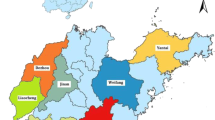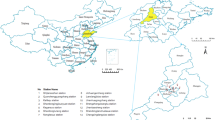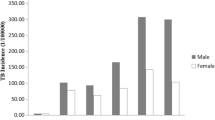Abstract
There has been a gap regarding current knowledge of the effect of PM on pulmonary TB, such as the exposure-time-response between them. This study aimed to explore the distributed lag effects of particulate matter (PM) on active pulmonary tuberculosis (TB) and identify the vulnerable groups. A generalized additive mixed model combined with a distributed lag non-linear model was applied to quantify the association between PM and active pulmonary TB with adjustment for potential confounders. Relative risk (RR) and cumulative RR with 95% confidence interval (CI) were calculated to quantify the exposure-time-response. A total of 16,486 cases of active pulmonary TB were notified. Results suggested that a unit 10 µg/m3 increase of daily PM2.5 concentration was positively associated with active pulmonary TB morbidity at 36–115 lag day and RR reached maximum at 66 lag day (1.0076; 95%CI, 1.0031–1.0122), and the cumulative RR was 2.1940 (95%CI, 1.2292–3.9161). For PM10, this association was significantly positive at 73–117 lag day, and RR reached maximum at 100 lag day (1.0036; 95%CI, 1.0003–1.0067), and the cumulative RR was not significant. This study provides evidence that PM significantly associate with active pulmonary TB. Vulnerability to PM2.5 was identified in male, female, 0–18 ages, 19–64 ages, workers, and students. Our findings have significant implications for developing local strategies to prevent and reduce health impact in PM polluted areas.



Similar content being viewed by others
Data availability
The data of disease is not publicly available due to the strict requirement of Nation Health Commission of China for the confidentiality of notable infectious disease data. However, the data are available for research upon a necessary request to the correspondence (email: qshi@cqmu.edu.cn). The request should meet the framework of the Chinese data protection legislation and any required permission from the National Health Commission of the People’s Republic of China. The data request must specify the research purpose, specific method, expected results, results sharing plan, and whether it involves ethics and other details. Expect a time frame of at least 8–10 months for data requests to be processed.
References
Borgdorff MW, Sebek M, Geskus RB, Kremer K, Kalisvaart N (2011) The incubation period distribution of tuberculosis estimated with a molecular epidemiological approach. Int J Epidemiol 40:964–970. https://doi.org/10.1093/ije/dyr058
Chan CK, Yao X (2008) Air pollution in megacities in China. Atmos Environ 42:1–42. https://doi.org/10.1016/j.atmosenv.2007.09.003
Chen R, Chu C, Tan J, Cao J, Song W, Xu X, Jiang C, Ma W, Yang C, Chen B, Gui Y, Kan H (2010) Ambient air pollution and hospital admission in Shanghai, China. J Hazard Mater 181:234–240. https://doi.org/10.1016/j.scitotenv.2017.09.098
Chen Z, Wang JN, Ma GX, Zhang YS (2013) China tackles the health effects of air pollution. Lancet 382:1959–1960. https://doi.org/10.1016/S0140-6736(13)62064-4
Chen KY, Chuang KJ, Liu HC, Lee KY, Feng PH, Su CL, Lin CL, Lee CN, Chuang HC (2016) Particulate matter is associated with sputum culture conversion in patients with culture-positive tuberculosis. Ther Clin Risk Manag 12:41–46. https://doi.org/10.2147/TCRM.S92927
Chen F, Deng Z, Deng Y, Qiao Z, Lan L, Meng Q, Luo B, Zhang W, Ji K, Qiao X, Fan Z, Zhang M, Cui Y, Zhao X, Li X (2017) Attributable risk of ambient PM10 on daily mortality and years of life lost in Chengdu, China. Sci Total Environ 581–582:426–433. https://doi.org/10.1016/j.scitotenv.2016.12.151
China Tuberculosis Control Collaboration (CTCC) (2004) The effect of tuberculosis control in China. Lancet 364(9432):417–422. https://doi.org/10.1016/S0140-6736(04)16764-0
Cohen AJ, Brauer M, Burnett R, Anderson HR, Frostad J, Estep K, Balakrishnan K, Brunekreef B, Dandona L, Dandona R, Feigin V, Freedman G, Hubbell B, Jobling A, Kan H, Knibbs L, Liu Y, Martin R, Morawska L, Pope CA 3rd, Shin H, Straif K, Shaddick G, Thomas M, van Dingenen R, van Donkelaar A, Vos T, Murray CJL, Forouzanfar MH (2015) Estimates and 25-year trends of the global burden of disease attributable to ambient air pollution: an analysis of data from the Global Burden of Diseases Study. Lancet 389(10082):1907–1918. https://doi.org/10.1016/S0140-6736(17)30505-6
Filonchyk M, Yan H (2018) The characteristics of air pollutants during different seasons in the urban area of Lanzhou, Northwest China. Environ Earth Sci 77:763. https://doi.org/10.1007/s12665-018-7925-1
Houtmeyers E, Gosselink R, Gayan-Ramirez G, Decramer M (1999) Regulation of mucociliary clearance in health and disease. Eur Respir J 13:1177–1188. https://doi.org/10.1034/j.1399-3003.1999.13e39.x
Hu X, Jiang F, Ni W (2018) Floods increase the risks of hand-foot-mouth disease in Qingdao, China, 2009–2013: a quantitative analysis. Disaster Med Public Health Prep 12(6):723–729. https://doi.org/10.1017/dmp.2017.154
Huang Y, Yan Q, Zhang C (2018) Spatial–temporal distribution characteristics of PM2.5 in China in 2016. J Geovis Spat Anal 2(2):12. https://doi.org/10.1007/s41651-018-0019-5
Jiang F, Wei T, Hu X, Han Y, Jia J, Pan B, Ni W (2021) The association between ambient air pollution and scarlet fever in Qingdao, China, 2014–2018: a quantitative analysis. BMC Infect Dis 21(1):987. https://doi.org/10.1186/s12879-021-06674-8
Kan H, Chen R, Tong S (2012) Ambient air pollution, climate change, and population health in China. Environ Int 42:10–19. https://doi.org/10.1016/j.envint.2011.03.003
Lewis TC, Robins TG, Dvonch JT, Keeler GJ, Yip FY, Mentz GB, Lin X, Parker EA, Israel BA, Gonzalez L, Hill Y (2005) Air pollution associated changes in lung function among asthmatic children in Detroit. Environ Health Perspect 113:1068–1075. https://doi.org/10.1289/ehp.7533
Li Z, Mao X, Liu Q, Song H, Ji Y, Xu D, Qiu B, Tian D, Wang J (2019) Long-term effect of exposure to ambient air pollution on the risk of active tuberculosis. Int J Infect Dis 87:177–184. https://doi.org/10.1016/j.ijid.2019.07.027
Murray M, Oxlade O, Lin HH (2011) Modeling social, environmental and biological determinants of tuberculosis. Int J Tuberc Lung Dis 15(6):64–70. https://doi.org/10.5588/ijtld.10.0535
Naranbat N, Nymadawa P, Schopfer K, Rieder HL (2009) Seasonality of tuberculosis in an Eastern-Asian country with an extreme continental climate. Eur Respir J 34(4):921–925. https://doi.org/10.1183/09031936.00035309
Ni L, Chuang CC, Zuo L (2015) Fine particulate matter in acute exacerbation of COPD. Front Physiol 6(294):1–10. https://doi.org/10.3389/fphys.2015.00294
Ostro B, Broadwin R, Green S, Feng WY, Lipsett M (2006) Fine particulate air pollution and mortality in nine California counties: results from CALFINE. Environ Health Perspect 114:29–33. https://doi.org/10.1289/ehp.8335
Palanisamy GS, Kirk NM, Ackart DF, Shanley CA, Orme IM, Basaraba RJ (2011) Evidence for oxidative stress and defective antioxidant response in Guinea pigs with tuberculosis. PLoS ONE 6:e26254. https://doi.org/10.1371/journal.pone.0026254
Pan S, Ni W, Li W, Li G, Xing Q (2019) Effects of PM2.5 and PM10 on congenital hypothyroidism in Qingdao, China, 2014–2017: a quantitative analysis. Ther Adv Endocrinol Metab 10:2042018819892151. https://doi.org/10.1177/2042018819892151
Pope CA, Dockery DW (2006) Health effects of fine particulate air pollution: lines that connect. J Air Waste Manag Assoc 56:709–742. https://doi.org/10.1080/10473289.2006.10464485
Popovic I, SoaresMagalhaes RJ, Ge E, Marks GB, Dong GH, Wei X, Knibbs LD (2019) A systematic literature review and critical appraisal of epidemiological studies on outdoor air pollution and tuberculosis outcomes. Environ Res 170:33–45. https://doi.org/10.1016/j.envres.2018.12.011
Rohde RA, Muller RA (2015) Air pollution in china: mapping of concentrations and sources. PLoS One 10:e0135749. https://doi.org/10.1371/journal.pone.0135749
Samoli E, Analitis A, Touloumi G, Schwartz J, Anderson HR, Sunyer J, Bisanti L, Zmirou D, Vonk JM, Pekkanen J, Goodman P, Paldy A, Schindler C, Katsouyanni K (2005) Estimating the exposure-response relationships between particulate matter and mortality within the APHEA multicity project. Environ Health Perspect 113:88–95. https://doi.org/10.1289/ehp.7387
Tao NN, Li YF, Liu YX, Liu JY, Song WM, Liu Y, Geng H, Wang SS, Li HC (2019) Epidemiological characteristics of pulmonary tuberculosis in Shandong, China, 2005–2017: a retrospective study. Medicine (baltimore) 98(21):e15778. https://doi.org/10.1097/MD.0000000000015778
Vynnycky E (2000) Lifetime risks, incubation period, and serial interval of tuberculosis. Am J Epidemiol 152(3):247–263
Wang S, Hao J (2012) Air quality management in China: issues, challenges, and options. J Environ Sci 24:2–13. https://doi.org/10.1016/s1001-0742(11)60724-9
Wang ZS, Wu T, Che F, Wang S, Zhou YH, Qian XP, Wu XF (2010) Comparison between domestic and international ambient air quality standards (in Chinese). Res Environ Sci 23:253–260. https://doi.org/10.1631/jzus.A1000244
Wang HJ, Chen HP, Liu J (2015) Arctic sea ice decline intensified haze pollution in Eastern China. Atmos Ocean Sci Lett 8:1–9. https://doi.org/10.3878/AOSL20140081
World Health Organization (WHO) (2016) Global tuberculosis report 2016. http://www.who.int/tb/publications/global_report/en/. Accessed 1 Apr 2020
World Health Organization (WHO) (2018) Global tuberculosis report 2018. https://www.who.int/tb/publications/global_report/en/. Accessed 1 Apr 2020
Xing YF, Xu YH, Shi MH, Lian YX (2016) The impact of PM2.5 on the human respiratory system. J Thorac Dis 8(1):E69-74. https://doi.org/10.3978/j.issn.2072-1439.2016.01.19
Xu P, Chen Y, Ye X (2013) Haze, air pollution, and health in China. Lancet 382:2067. https://doi.org/10.1016/S0140-6736(13)62693-8
Yang G, Wang Y, Zeng Y, Gao GF, Liang X, Zhou M, Wan X, Yu S, Jiang Y, Naghavi M, Vos T, Wang H, Lopez AD, Murray CJ (2013) Rapid health transition in China, 1990–2010: findings from the Global Burden of Disease Study 2010. Lancet 381(9882):1987–2015. https://doi.org/10.1016/S0140-6736(13)61097-1
You S, Tong YW, Neoh KG, Dai Y, Wang CH (2016) On the association between outdoor PM2.5 concentration and the seasonality of tuberculosis for Beijing and Hong Kong. Environ Pollut 218(2016):1170–9. https://doi.org/10.1016/j.envpol.2016.08.071
Zhang XL (2017) Spatial-temporal analysis of pulmonary tuberculosis in Shandong province, 2015. EC Pulmonology and Respiratory Medicine 4(5):160–168
Zhang Y, Ni H, Bai L, Cheng Q, Zhang H, Wang S, Xie M, Zhao D, Su H (2019) The short-term association between air pollution and childhood asthma hospital admissions in urban areas of Hefei City in China: a time-series study. Environ Res 169:510–516. https://doi.org/10.1016/j.envres.2018.11.043
Zhao Y, Xu S, Wang L, Chin DP, Wang S, Jiang G, Xia H, Zhou Y, Li Q, Ou X, Pang Y, Song Y, Zhao B, Zhang H, He G, Guo J, Wang Y (2012) National survey of drug-resistant tuberculosis in China. New Engl J Med 366:2161–2170. https://doi.org/10.1056/NEJMoa1108789
Zou JH, Xu FX, Zou B, Li SX (2018) Spatial-temporal characteristics of haze in the key tourism cities of China (in Chinese). Trop Geo 38:143–150
Acknowledgements
We thank the Chinese Center for Disease Control and Prevention, National Meteorological Information Center of China, and the Data Center for the Institute of Geographic Sciences and Natural Resources Research of China for sharing with us the data needed for this study.
Funding
This work was supported by Chongqing Graduate Research Innovation Project (Grant No. CYB22224), project supported by Peking University People’s Hospital Scientific Research Development Funds (Grant No. RDJP2022-63), and Medical and Health Technology Development Plan Project of Shandong Province (Grant No. 20220503137).
Author information
Authors and Affiliations
Contributions
WN conducted the literature review and analyses, drafted the manuscript, and approved the final manuscript as submitted. QS attributed to the conceptualization and critically reviewed the manuscript and approved the final manuscript as submitted.
Corresponding author
Ethics declarations
Ethics approval
Ethical approval was not required for this study.
Consent to participate
Not applied.
Consent for publication
All authors approve the manuscript and give their consent for submission and publication.
Conflict of interest
The authors declare no competing interests.
Supplementary Information
Below is the link to the electronic supplementary material.
Rights and permissions
Springer Nature or its licensor (e.g. a society or other partner) holds exclusive rights to this article under a publishing agreement with the author(s) or other rightsholder(s); author self-archiving of the accepted manuscript version of this article is solely governed by the terms of such publishing agreement and applicable law.
About this article
Cite this article
Ni, W., Shi, Q. Distributed lag effects and vulnerable groups of PM and active pulmonary TB in Qingdao, China. Int J Biometeorol 68, 179–188 (2024). https://doi.org/10.1007/s00484-023-02581-6
Received:
Revised:
Accepted:
Published:
Issue Date:
DOI: https://doi.org/10.1007/s00484-023-02581-6




